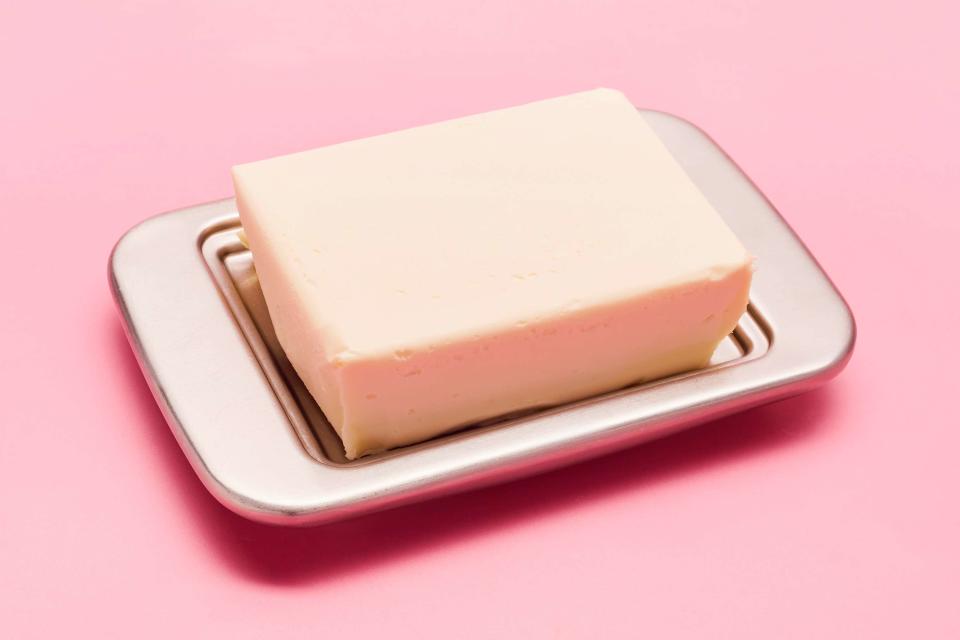Margarine vs. Butter: Which Is Better to Use?
The answer is a little bit complicated.

The Burtons/Getty Images
Butter, margarine, and plant-based butters all offer a bit of creamy goodness that you can spread onto your toast or include in your recipes. But each of these buttery food products bring something a little different to the table, and you may want to consider switching it up, depending on your health goals and your palate.
Related: The 9 Most Common Types of Butter—Plus the Best Ways to Use Them
Get the full scoop on the margarine vs. butter vs. plant-based butter debate—and which one might be best for your cooking (and your breakfast!).
What Is Margarine Made Of?
Every margarine maker has their own secret recipe, but the basis of margarine is vegetable oils like palm, corn, canola, olive, flaxseed, or soybean oils. That's usually whipped in with water, salt, and natural or artificial flavorings—though some margarine makers do include some dairy milk or whey in lieu of water to give it a more butter-like flavor and texture.
How Is Plant-Based Butter Different From Margarine?
The short answer: It generally isn't. Most margarines are essentially plant-based butters, making them ideal to use in vegan cooking and baking. If the label doesn't say that it's plant-based or vegan, check the ingredients list for milk, lactose, whey, or casein, which would indicate that there are dairy ingredients in it.
Related: 20 Vegan Dessert Recipes That Are So Tasty You’ll Want to Make Them ASAP
How Is Butter Made?
If you've ever done the classic DIY butter churning (a lidded jar, a marble, heavy cream, and a lot of shaking)—or left your heavy cream whipping a little bit too long—you know the basics of making butter. Milk or cream is shaken, churned, or whipped until it separates—the fat solidifies into butter, and the liquid that remains is buttermilk.
While most butter in the U.S. comes from cow's milk, it can also be made from goat, sheep, yak, or buffalo milk. These other animal milks give the butter a slightly different flavor.
Once the butter is produced, it can then be salted, which helps it last a bit longer (and adds a bit more flavor) or can be offered unsalted.
Related: What Is European Style Butter and Why Isn't It in Your Fridge?
Is Margarine or Plant-Based Butter Healthier Than Butter?
The answer to this question is a bit complicated. Many plant-based butters and margarines are made with vegetable oils that use unsaturated fats. But stick-based margarines may include both saturated and unsaturated fats in their margarine recipe, to give it a more butter-like texture. Meanwhile, animal-based butters are made of saturated fats.
Several studies have found that a diet rich in unsaturated fats can help improve cholesterol levels, while saturated fats raise LDL cholesterol levels (AKA low-density lipoprotein cholesterol, the "bad" type of choleseterol) in the blood.
Related: 10 Nutritious Foods for Healthy Cholesterol Levels
The jury is still out on whether saturated fats impact your cardiovascular health, with some studies pointing to a link between saturated fats and cardiovascular disease, while others don't find that link.
Calorie-wise, you won't find much of a difference between margarine and butter, as they both contain about 36 calories per teaspoon.
How to Use Margarine or Butter in Your Recipes
Margarine and plant-based butters can be used in a one-for-one swap when recipes call for butter. But you'll need to pay attention to a few differences, as they will impact your finished product.
For baking, opt for one of the stick-style butters to ensure a similar consistency to butter. Tubbed margarine will be too soft and could affect the texture of your baked goods. Also, since even the stick margarine is softer than stick butter, you'll be able to use it right out of the fridge for recipes that call for softened butter.
Using margarine may impact the texture of pie crusts, biscuits, and other baked goods that call for using chilled or frozen butter. You will find that the finished product is a bit softer with margarine than it is when you use butter.
Related: The 7 Healthiest Cooking Oils—and Which to Avoid
For cooking, the smoke point of the margarine you use will be similar to the smoke point of the oils in it—so it may or may not be able to stand up to frying or sautéing. (For instance, flaxseed oil has a smoke point of 225 degrees Fahrenheit, while butter's smoke point is higher, at 350 degrees.) If you do want to use margarine for cooking, ensure that it's made from an oil that has a high enough smoke point, such as olive oil, avocado oil, or soybean oil.
Another consideration: Most margarine contains some salt, so you may want to reduce or cut out any salt that's in the recipe if it calls for unsalted butter to avoid a too salty taste.
For more Real Simple news, make sure to sign up for our newsletter!
Read the original article on Real Simple.

